What's the difference between filtered and unfiltered honey?
Select independently determines what we cover and recommend. When you buy through our links, we may earn a commission. Learn more.
The first image that comes to mind when you think about honey is likely bear-shaped bottles filled with a golden, sweet, sticky liquid. Or perhaps you see bees hard at work collecting nectar, buzzing between flowers before returning to their hive. Either way, honey is a common pantry staple known for its culinary and medicinal benefits. You can add it to coffee or tea, cook and bake with it or eat spoonfuls of it when you have a sore throat. But not all honey is the same. Some options taste earthy or fruity, and they can vary in texture from smooth and creamy to light and drizzle-able.
SKIP AHEAD How does honey get its flavor? | Filtered versus unfiltered | Does honey expire?
We spoke to experts about what to look for in honey when shopping, along with the unique flavor profiles that make up their favorite picks.
Related: We talked to founders of Black-owned coffee companies about their experiences in the industry.
Best honey to shop
The two biggest factors that impact your honey selection are flavor and intended usage. You might prefer a creamed variety with herbal notes to spread on your toast, or a sweeter, lighter option to stir into your tea. But regardless of your preference, experts recommend you look for raw, unfiltered honey.
Honey naturally contains pollen, vitamins, enzymes and minerals, which gives the sweet stuff its health benefits, like throat relieving properties and the ability to help treat eczema, said Rupam Brar, a pediatric allergist and immunologist at New York University’s Hassenfeld Children’s Hospital. Filtering honey — a process that involves heating it to make it smoother and prevent crystallization over time — strips it of these nutrients.
Along with looking for raw and unfiltered, you should aim to find pure honey, which means it doesn’t contain any artificial additives or quality-degrading fillers. Flavors like chili, lavender, and cocoa can taste great, but make sure the infused ingredients are coming from natural sources to preserve the quality, said Summer Johnson, who owns Zach & Zoe Sweet Bee Farm (one of our favorite Black-owned businesses) with her husband Kam.
We rounded up expert-recommended honey varieties, all of which are raw, unfiltered and pure, according to the brands.
Zach & Zoe Sweet Bee Farm Goldenrod Honey
One of the most prevalent flowers in New Jersey, where Zach & Zoe Bee Farm is located, are solidago, or commonly called goldenrods. “When bees pollinate [the flower], it has a really buttery, rich flavor,” said Johnson. You can purchase the company’s goldenrod honey in a 16-ounce jar.
Zach & Zoe Sweet Bee Farm Goldenrod Honey
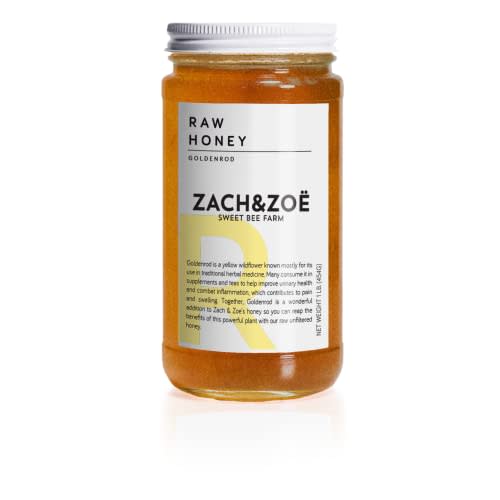
Zach & Zoe Sweet Bee Farm Goldenrod Honey $ at Zach & Zoë
Zach & Zoe Sweet Bee Farm Goldenrod Honey $ at Amazon
Gowanus Apiary Carroll Gardens Honey
“Wildflower honey makes up the bulk of the honey we have here in the United States,” said owner of Gowanus Apiary, Bruce Shriver. “Wildflower simply means that bees collect nectar from a variety of sources and we can’t attribute it to one single source.” The bees at Gowanus Apiary collect nectar from flowers and plants across Brooklyn, and what they pollinate changes from season to season. Shriver said this honey — which you can purchase in 5.2-ounce, 8.8-ounce or 12.9-ounce jars — has a floral flavor.
Gowanus Apiary Carroll Gardens Honey

Gowanus Apiary Carroll Gardens Honey $ at Gowanus Apiary
Wedderspoon Raw Monofloral Manuka Honey
According to Johnson, Manuka honey can only be found where there are Manuka bushes for bees to gather nectar from, such as Australia and New Zealand, which is why this type of honey is usually more expensive compared to other varieties. It’s highly sought after because it contains greater microbial properties and stronger antibiotic compounds than other types of honey, Shriver said, and people use it for wound dressings, skin ailments like eczema, and to promote oral and digestive health.
Wedderpoon says its authentic Manuka honey is harvested and packed in New Zealand. It’s available in containers that range in type and size, like a 12-ounce squeeze bottle, 17.6-ounce container or 8.8-ounce container.
Wedderspoon Raw Monofloral Manuka Honey

Wedderspoon Raw Monofloral Manuka Honey $ at Wedderspoon
Wedderspoon Raw Monofloral Manuka Honey $ at Amazon
Sandt’s Orange Blossom Honey
If you prefer a fruitier flavor profile, try an orange blossom honey. It comes from bees that pollinate orange tree blooms and has notes of citrus, according to Shriver. Sandt’s Orange Blossom Honey comes from nectar gathered from the Florida orange groves, the brand says. It comes in a 32-ounce bottle — experts told us honey never expires, so this larger bottle could last you a while, depending on how frequently you use it.
Sandt’s Orange Blossom Honey
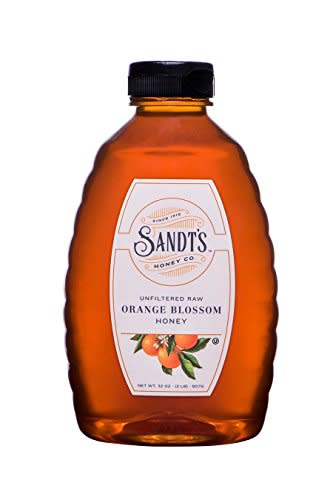
Sandt’s Orange Blossom Honey $ at Amazon
Astor Apiaries Buckwheat Blossom Raw Honey
The flavor of buckwheat honey, which is made from bees pollinating buckwheat plants, is gamier compared to wildflower honey, said Johnson, and slightly bitter, added Shriver. The honey is dark in color and has notes of chocolate and molasses, according to the brand. You can purchase the honey in a 3-ounce or 12-ounce jar.
Astor Apiaries Buckwheat Blossom Raw Honey
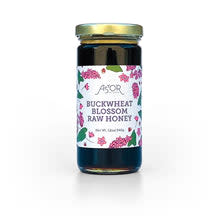
Astor Apiaries Buckwheat Blossom Raw Honey $ at Astor Apiaries
Andrew’s Honey Whipped Honey
Whipped honey — also called creamed or spun honey — is crystallized honey that has very fine crystals, giving it a smooth, solid texture, similar to that of a nut butter. It’s also more opaque in color. You can smear whipped honey on toast (which is my favorite way to eat it) or even eat spoonfuls of it. Andrew’s Honey sells whipped honey in 12-ounce jars and you can choose from original, cinnamon, blueberry or apricot flavors.
Andrew’s Honey Whipped Honey

Andrew’s Honey Whipped Honey $ at Andrew's Honey
Crystal’s Honey Clover Honey
Clover honey is one of the most common types you’ll notice while browsing your local grocery store’s collection, according to Huertas. Bees collect nectar from clover plants to make this variety, which has a more mild flavor, according to Shriver. You can purchase clover honey from Crystal’s Honey in 8.8-ounce or 17-ounce jars, as well as a 2.75-pound container.
Crystal’s Honey Clover Honey

Crystal’s Honey Clover Honey $ at Crystal's Honey
Crystal’s Honey Clover Honey $ at Amazon
Savannah Bee Company Acacia Honeycomb
Acacia honey has light, floral notes, and some people taste hints of vanilla, Shriver said. This type of honey is made when bees collect nectar from flowers on black locust trees. Savannah Bee Company offers acacia honey in a 12-ounce jar and the honeycomb is included inside. Shriver said honeycomb is “all natural, brand new beeswax,” and beekeepers or brands may package jars of honey with a piece of comb inside (often called chunk honey) because people like to chew on and spit out (similar to gum), or swallow it.
Savannah Bee Company Acacia Honeycomb
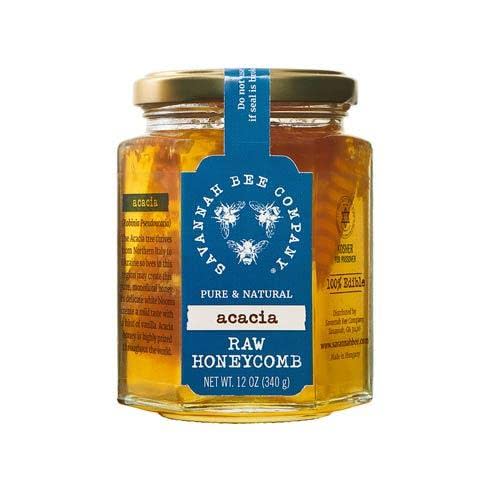
Savannah Bee Company Acacia Honeycomb $ at Savannah Bee Company
Savannah Bee Company Acacia Honeycomb $ at Amazon
HoneyGramz Linden Honey
Linden honey has an herbal flavor that Shriver said people sometimes describe as “minty.” Bees pollinate the blossoms on Linden trees to create this specific variety. You can purchase Linden honey from HoneyGramz in 8-ounce bottles.
HoneyGramz Linden Honey

HoneyGramz Linden Honey $ at HoneyGramz
Smiley Honey Tupelo Honey
“As far as I’m concerned, tupelo honey has got to be the most wonderful honey in the world,” Shriver said. The honey comes from the white tupelo tree, which is native to the South Eastern United States. Florida and Georgiahave the highest concentration of these trees, and that’s where experts said that most tupelo honey comes from. Tupelo honey can be rare to find — the blossoms bees collect nectar from last for about three weeks in the spring. Smiley Honey offers tupelo honey in multiple types of containers and sizes, including a 1, 2 or 5-pound plastic bottle and a 2-ounce baby bear.
Smiley Honey Tupelo Honey
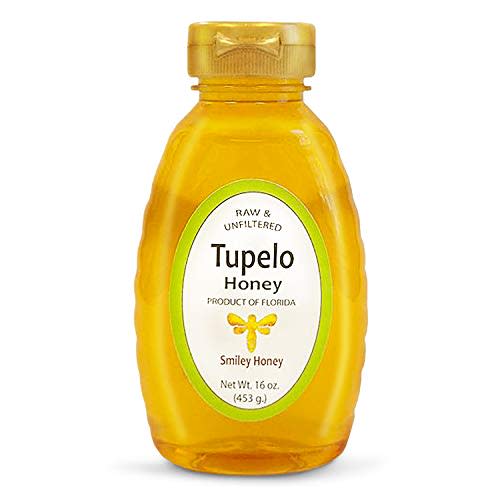
Smiley Honey Tupelo Honey $ at Smiley Honey Co.
Smiley Honey Tupelo Honey $ at Amazon
Edisto Gold Honey Lavender-Infused Raw Honey
Honey that is infused with natural food products rather than artificial flavorings, retains its overall quality, according to the experts we interviewed. Edisto Gold Honey offers lavender-infused honey — it’s made by mixing the brand’s honey with organic lavender powder. You can purchase it in an 8-ounce jar.
Edisto Gold Honey Lavender-Infused Raw Honey

Edisto Gold Honey Lavender-Infused Raw Honey $ at Edisto Gold Honey
Related: Experts explain how to find laundry detergent that’s better for you and the environment.
How does honey get its flavor?
“The main factor that impacts the flavor of honey is what bees are pollinating,” said Johnson. “When bees go out and get nectar that makes the honey, they’re pulling it from different flowers and plants, which influences the taste.” Flower and plant varieties bloom at varying points during the year, so as the seasons change, so does what’s available for bees to pull nectar from.
Location also impacts honey’s flavor given that each region, state and country grows different flowers. “In Southern California, some common floral sources that bees pollinate from are citrus and sage, whereas in Texas, common sources are cotton and tallow,” said Huertas. In contrast, Zach & Zoe Honey Farm is located in New Jersey, and one of the main wildflowers bees have access to is goldenrod. Therefore, the different regions can produce types of honey that are unique, similar to coffee beans or wine.
Filtered, unfiltered, raw and organic honey: What’s the difference?
Filtered honey
Filtered honey is heated, strained through a fine filter and rapidly cooled before being bottled to help prevent it from crystallizing over time, Huertas said. This process removes air bubbles, pollen and other fine particles from the honey to give it a smoother texture and “stretches honey out so there’s more to sell,”according to Johnson. The experts we spoke to recommended against buying filtered honey. “As you heat honey, you lose nutrients and flavor notes, which is what makes honey delicious and good for you,” explained Johnson.
Raw and unfiltered honey
”Raw” and “unfiltered” are often used interchangeably when describing honey that does not undergo a heat treatment or pasteurization process before being bottled. It doesn't lose any of its nutrients as it gets transferred from the hive into a container, therefore the honey is in its rawest form when it gets to consumers. Raw honey is not heated at all, but sometimes unfiltered honey is very briefly warmed if it begins to crystallize before it’s bottled, Shriver said.
Since there’s nothing stopping raw, unfiltered honey from naturally crystallizing, you may notice that it looks solid in the jar when you purchase it or after it’s been sitting in your pantry for a while. “For lots of people, that’s sort of a turn off,” Shriver said. “Some people believe that crystallized honey is bad or not fresh, but that’s not true.” He noted that crystallized honey dissolves immediately when you mix it into beverages or food, and you can easily re-liquify crystallized honey by placing the container in a bowl of warm water until you notice the texture start to change.
Organic honey
Organic honey means that the flowers and plants bees harvest to make that honey are 100 percent organic. Johnson said making organic honey is very hard to do, and the only way to ensure honey is 100 percent organic is to quarantine bees in a dome with only organic blooms to harvest nectar from.
Health benefits of honey
Beyond using honey to cook and bake, or to sweeten your favorite beverages, one of the most common circumstances in which some people turn to raw, local honey is when they’re looking for ways to alleviate seasonal allergy symptoms. In fact, Brar said she gets asked about it a lot. Bees pick up what’s in their environment while harvesting nectar, which may include what you’re allergic to, like plant pollen. When you ingest these allergens through honey, you’re exposing your body to them, and it’s thought that this may help you build up an immunity to them. But does it work?
“Honey is a great adjunctive treatment but cannot replace allergy medication,” Brar said. She noted that honey also has antibacterial and anti-inflammatory properties, which can help relieve a sore throat or treat skin conditions like eczema. But make sure you do not give honey to children under 1 year old due to risk of botulism, a rare illness that can happen if you ingest toxins from a certain type of bacteria, Brar said.
Does honey expire?
No, honey does not expire, experts told us. Over time, you may notice that raw, unfiltered honey gets cloudy and starts to solidify or crystallize, but that does not mean it’s expiring or “going bad,” according to our sources. The Food and Drug Administration also notes that cloudy, solidified, crystallized honey is “not a safety concern.”
The best place to store your honey is out of direct sunlight and at room temperature, Huertas said. If exposed to bright sunlight consistently, honey can lose its flavor and darken in color, similar to how light can degrade olive oil over time. If it’s stored in too cool of a location, honey may begin to crystallize faster than if stored at room temperature. This is also why you should not refrigerate honey — the cold temperature will cause it to seize up and crystallize quickly. It’s also important to keep honey in a container with an airtight seal because it’s hydroscopic, meaning it absorbs moisture from the air if it’s not covered, Shriver said.
Meet our experts
At Select, we work with experts who have specialized knowledge and authority based on relevant training and/or experience. We also take steps to ensure that all expert advice and recommendations are made independently and with no undisclosed financial conflicts of interest.
Bruce Shriver is a beekeeper and owner of Gowanus Apiaries in Carroll Gardens, Brooklyn.
Summer Johnson owns Zach & Zoe Sweet Bee Farm with her husband, Kam.
Ana Maria Huertas is a honey global category merchant at Whole Foods Market.
Dr. Rupam Brar is a pediatric allergist and immunologist at New York University’s Hassenfeld Children’s Hospital. She specializes in the research and treatment of pediatric allergies and eczema. She is the proud mom of three kids with allergies.
Catch up on Select's in-depth coverage of personal finance, tech and tools, wellness and more, and follow us on Facebook, Instagram and Twitter to stay up to date.
